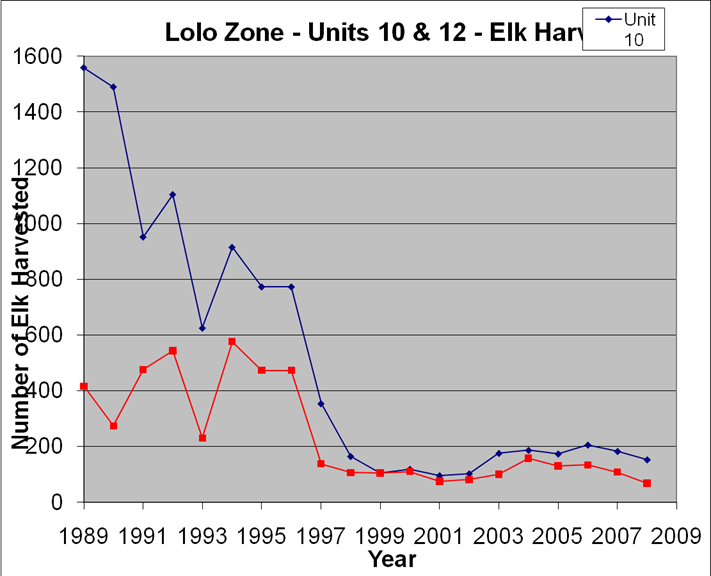Controversy over wolves and elk was predicted before wolves entered the area-
Idaho Fish and Game reports it has used a helicopter to kill 23 wolves in the north central Idaho area commonly called the Lolo. This is the latest in a continuing effort (6 forays in 4 years) to reduce the number of wolves there by 70%. In recent years IDF&G has also had very generous hunting rules to kill cougar and bear. Here is the story from the media — Associated Press in the Missoulian. “Idaho Fish and Game kills 23 wolves in Lolo Pass area.”The point of these efforts is to try to bring back the once mighty elk herd that roamed the area. The Lolo became famous for elk in the 1940s through the 80s. The size of the herd stemmed from the regeneration of the great forest fire of 1910 and later fires. Regeneration provided perfect conditions to result in a large number of elk. Elk numbers were legendary and became part of hunting lore.
Unfortunately for the elk herd, the burned forest did not only regenerate. It advanced to maturity resembling the conditions when Lewis and Clark traversed the area and almost starved due to lack of game. Predictions were this maturity would cause elk numbers to crash and remain low indefinitely (until the habitat was “reborn”). As predicted, the crash happened. The elk population peaked last in 1989 at an estimated 16,054. Then came a sharp drop, almost a cliff, but by then politics dictated a new and logically impossible explanation for the crash — wolves.
We first drove down the Lochsa River in the spring of 1976. It was new country for me — beautiful, primitive or Wilderness country just beyond Highway 12. There was, however, the interesting distraction of numerous fires burning on the slopes just north of the highway. We learned these fires were set in an effort to forestall the coming decline in elk habitat. We almost hit an elk on the highway and saw quite a few more.
In those days there were plenty of bear and cougar were increasing. Cougar had recently become a protected game animal in Idaho. No one spoke of predation as a factor. That would come later in the mid-1990s. After the first drop in the early 90s, the elk herd took another hit in 1995-6 with a big die-off in a severe winter. Afterwards the low population recovered but little, and drifted slowly downward. Today (2014) there are only about 2200 elk.
Wolves were reintroduced to Idaho in 1995 and 1996, but none to the Lolo. Wolves eventually made their way north to the Lolo, but their numbers were not significant until at least 5 years later — about the year 2000.
See below the actual decline in elk killed by hunters by year in units 10 and 12 — “The Lolo Zone.”
We see that the huge drop in elk populations came before the wolves. Therefore, wolves could not have been responsible for the elk herd’s drop off the cliff. They could not have been, at least in this universe where a cause has to come before the effect.
At the time of the big crash, I predicted wolves would, nevertheless, be blamed. Anti-wolf groups were gearing up. They likely figured that many hunters did not have the time sequence of events clearly in mind. Politicians soon joined in and the future path for Idaho Fish and Game was set in political concrete.
From the Lolo, anti-wolf forces then took the misinterpreted data and added to it the big drop in Yellowstone Park’s northern range elk herd. This became standard fare to show how wolves hammered elk. Nevertheless in 2010, Idaho Fish and Game wrote “But elk numbers have not declined everywhere – 10 of Idaho’s 29 elk zones are above management objectives for female elk, 13 zones are within objectives and six are below objectives.”
Agencies did not bother to even name the zones where elk numbers were stable, or even growing inspite of an increasing wolf population, such as the Hells Canyon Elk Zone, the Brownlee Zone, the Weiser River Zone; or the Snake River and Pioneer Zones where there are wolves, but “too many elk,” where elk will be reduced to please agricultural interests. Are these elk somehow less important than deep backcountry elk?
Nonetheless, the conventional wisdom became elk were almost extinct in Idaho, disinformation that IDF&G did not actively dispute even though it brought great harm to the department’s revenue when hunters shunned the state.
On the contrary, Idaho Fish and Game launched their campaign to nearly rid the Lolo of wolves and other large predators at a high monetary cost. Meanwhile in reality, in their new Idaho Elk Management Plan, Fish and Game reports a statewide elk population of 107,000 animals.
Now Idaho Fish and Game plans to go after wolves
What will happen in the Lolo? After 4 years of a war on native Idaho carnivores, we should expect to be seeing an increase in elk if predators are the reason elk numbers have remained low. This is a logically possible explanation. However, the habitat for elk has not clearly improved. There have been some new forest fires and these burned areas should eventually lead to new habitat. The fires have not yet been extensive, and it isn’t clear that the fire-opened areas are growing elk food instead of the invasive spotted knapweed. This noxious invader was not present back in 1940. In the new elk management plan, weeds are blamed for lower elk numbers in a number of hunting zones in Idaho. Why not the Lolo? It might be politically appropriate to speak only of other zones.
source


No comments:
Post a Comment